The Closed-die Forging Process – Cooling the Forged Parts
2023-09-16
Once the metal is forged (discussed in the previous NEWS), it begins to cool. There are many steps required to separate the component from the rods we use to forge the shape.
Excess metal
As the metal passes through the closed die forging process, excess metal (flash) is removed from the forging by a trimming tool in the press located next to the forging hammer.
Then let the forging cool and wait to move on to the next process.
Heat treatment of forging
Depending on the properties required by the forging stage design standards, there are many heat treatment methods to choose from, the most common being:
· normalization
· annealing
• Hardening and tempering
Rust removal
Parts are usually scaled after heat treatment. The parts are then checked for surface forging defects and, of course, dimensions.
environment
All metal scraped off during the forging process is recyclable. It is crushed and sold back to the factory, which melts the metal and forms a rod for resale.
Health and safety during forging
Handling forged parts is dangerous due to the high temperatures. Therefore, when taking out parts from the forge or during the forging process, all workers should wear ear protection, safety glasses, steel cap boots, flame retardant personal protective clothing for protection.
Watch Maple for the next step in the closed die forging process.
Maple Forging has always provided high quality forging services. We have been providing forgings for European and American companies and have a deep understanding of the industry. Please send us an inquiry immediately to discuss your closed die forging requirements.
























































